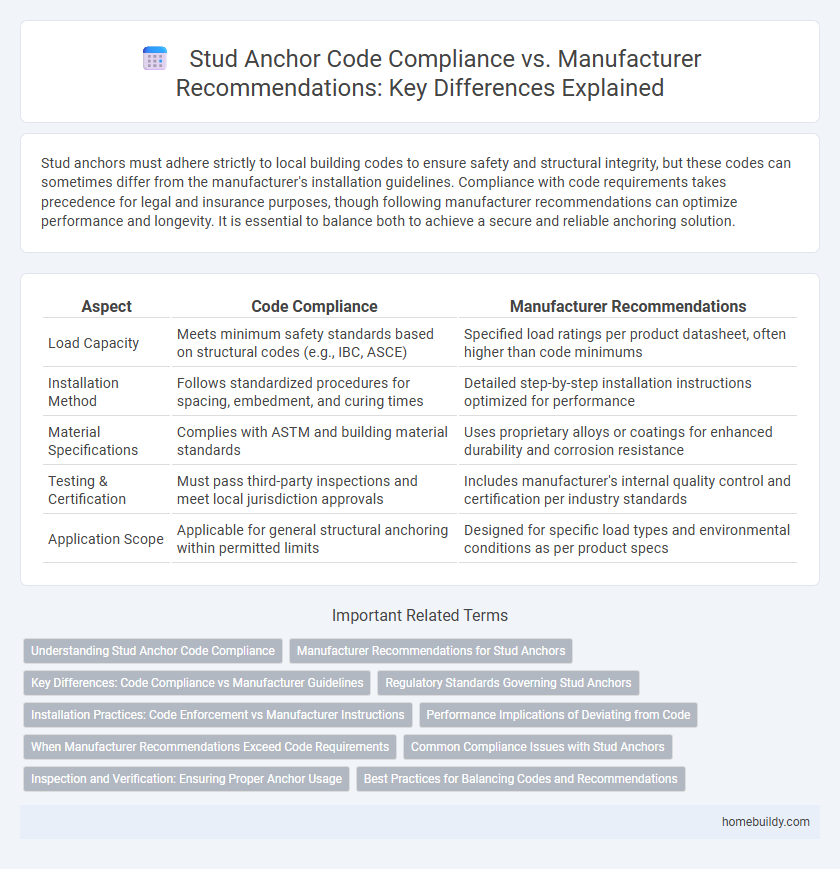Stud anchors must adhere strictly to local building codes to ensure safety and structural integrity, but these codes can sometimes differ from the manufacturer's installation guidelines. Compliance with code requirements takes precedence for legal and insurance purposes, though following manufacturer recommendations can optimize performance and longevity. It is essential to balance both to achieve a secure and reliable anchoring solution.
Table of Comparison
| Aspect | Code Compliance | Manufacturer Recommendations |
|---|---|---|
| Load Capacity | Meets minimum safety standards based on structural codes (e.g., IBC, ASCE) | Specified load ratings per product datasheet, often higher than code minimums |
| Installation Method | Follows standardized procedures for spacing, embedment, and curing times | Detailed step-by-step installation instructions optimized for performance |
| Material Specifications | Complies with ASTM and building material standards | Uses proprietary alloys or coatings for enhanced durability and corrosion resistance |
| Testing & Certification | Must pass third-party inspections and meet local jurisdiction approvals | Includes manufacturer's internal quality control and certification per industry standards |
| Application Scope | Applicable for general structural anchoring within permitted limits | Designed for specific load types and environmental conditions as per product specs |
Understanding Stud Anchor Code Compliance
Stud anchor code compliance ensures structural safety by adhering to standards set by organizations like ICC and ASTM, which often align with but can differ from manufacturer recommendations. Understanding these codes involves recognizing the required testing protocols, load capacities, and installation guidelines mandated by authorities having jurisdiction (AHJ). Balancing code compliance with manufacturer specifications is crucial for achieving both legal approval and optimal performance in construction projects.
Manufacturer Recommendations for Stud Anchors
Manufacturer recommendations for stud anchors prioritize specific installation procedures, load ratings, and environmental conditions to ensure optimal performance and safety. Adhering to these guidelines helps prevent premature failure, ensures structural integrity, and maintains warranty validity. Compliance with manufacturer instructions frequently surpasses general code requirements by addressing product-specific nuances critical for reliable anchoring in diverse applications.
Key Differences: Code Compliance vs Manufacturer Guidelines
Stud anchors must meet local building codes which ensure structural safety and legal adherence, while manufacturer recommendations provide detailed installation procedures and performance specifications to maximize anchor effectiveness. Key differences lie in the fact that code compliance establishes mandatory minimum requirements, whereas manufacturer guidelines offer optimized practices tailored to specific product characteristics. Ignoring either can compromise anchor reliability, making it critical to balance regulatory standards with manufacturer expertise for optimal stud anchor performance.
Regulatory Standards Governing Stud Anchors
Stud anchors must comply with regulatory standards such as ASTM F1554 and ICC-ES AC193, which set stringent requirements for tensile strength, installation, and corrosion resistance. Although manufacturers provide specific installation guidelines tailored to product performance, adherence to local building codes and regulatory frameworks remains mandatory to ensure structural safety and legal compliance. Balancing manufacturer recommendations with codes like IBC and ACI 318 guarantees optimal anchor performance and reduces risk in construction projects.
Installation Practices: Code Enforcement vs Manufacturer Instructions
Installation practices for Stud anchors must balance code enforcement requirements with manufacturer instructions to ensure safety and structural integrity. Building codes often mandate specific torque values, embedment depths, and inspection protocols that may differ from manufacturer guidelines, emphasizing uniformity and regulatory compliance. Adhering strictly to manufacturer instructions guarantees product performance and warranty validity, but blending these with local code provisions is essential to meet both legal and functional standards.
Performance Implications of Deviating from Code
Deviating from Stud anchor code compliance can significantly compromise load-bearing capacity, leading to structural failures and increased liability risks. Manufacturer recommendations provide optimized installation guidelines that align with tested performance parameters but may not cover local code requirements, potentially resulting in non-compliance penalties. Ensuring strict adherence to both code and manufacturer specifications is critical for maintaining anchor reliability, safety margins, and overall project integrity.
When Manufacturer Recommendations Exceed Code Requirements
Stud anchors often require adherence to both building codes and manufacturer recommendations, with the latter sometimes exceeding minimum code requirements to ensure enhanced safety and performance. Manufacturers may specify higher load capacities, tighter installation tolerances, or more rigorous testing standards than those mandated by building codes, addressing specific material conditions or environmental factors. Compliance with these stricter manufacturer guidelines can prevent anchor failure and contribute to the overall structural integrity of the installation.
Common Compliance Issues with Stud Anchors
Common compliance issues with stud anchors typically involve deviations from manufacturer recommendations regarding embedment depth, spacing, and concrete strength requirements. Failure to adhere to specified torque values or improper installation techniques also lead to non-compliance, compromising anchor performance and safety. Ensuring strict alignment with applicable building codes and manufacturer guidelines mitigates risks related to load capacity and long-term structural integrity.
Inspection and Verification: Ensuring Proper Anchor Usage
Inspection and verification of stud anchors must strictly adhere to manufacturer recommendations to guarantee safety and structural integrity. Code compliance requires regular checks for corrosion, installation torque, embedment depth, and load capacity as specified by industry standards such as ACI 318 and ICC ES reports. Deviating from these guidelines risks anchor failure, making thorough documentation and periodic testing essential for proper anchor usage.
Best Practices for Balancing Codes and Recommendations
Stud anchor code compliance requires adherence to local building codes and industry standards such as ICC-ES AC193, ensuring structural safety and legal approval. Manufacturer recommendations provide specific installation techniques and load capacities that optimize performance and durability of the stud anchors. Balancing these elements involves verifying code requirements first, then integrating manufacturer guidance for correct embedment depth, torque values, and environmental conditions to achieve both compliance and optimal anchor function.
Stud anchor code compliance vs manufacturer recommendations Infographic

 homebuildy.com
homebuildy.com